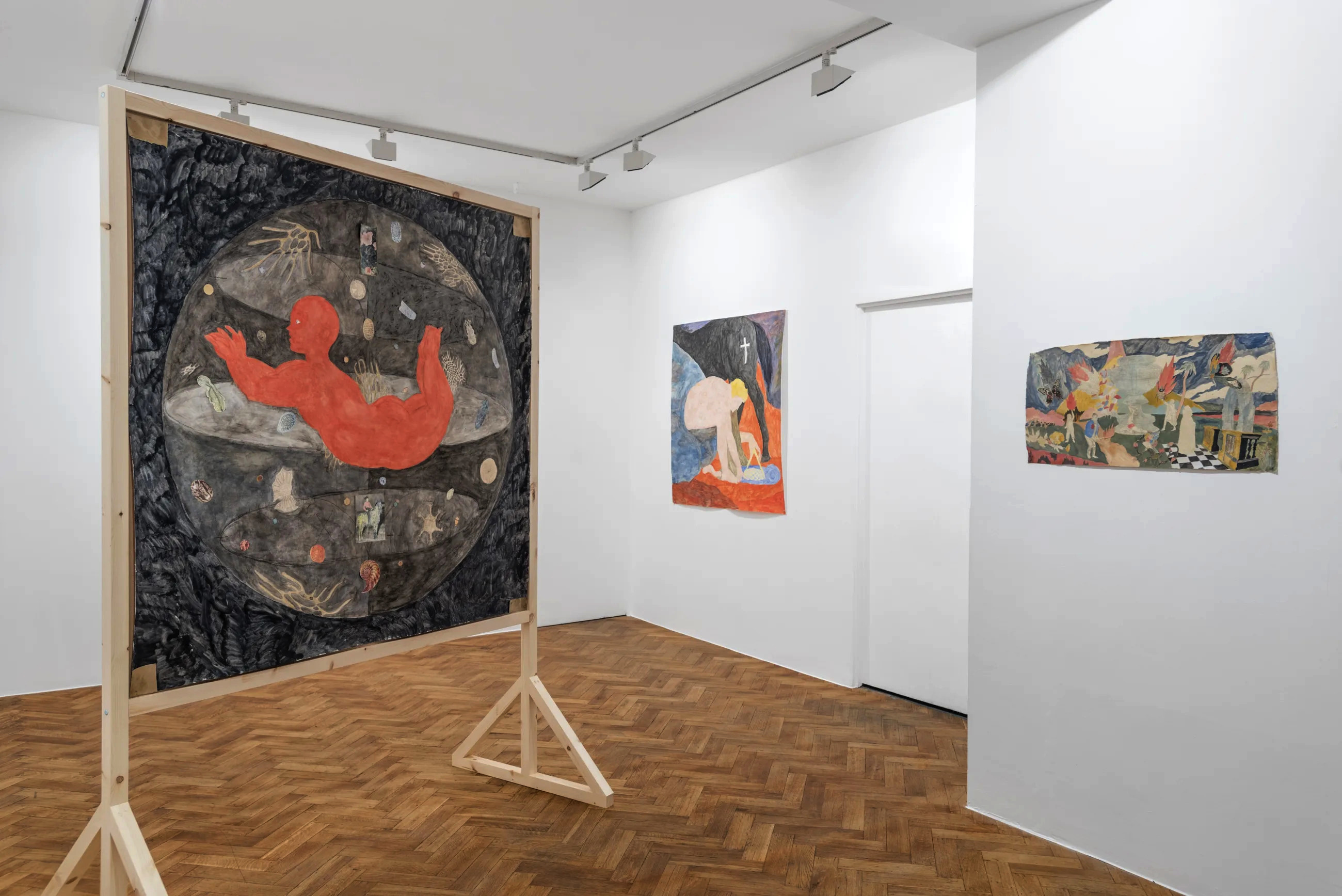DREAM-BRIDGE-OMNIGLYPH
London Mithraeum - Bloomberg Space
London, UK
01/02/2024 - 29/06/2024
Inspired by the Roman Temple of Mithras discovered on the Bloomberg site, Robinson explores the ancient myth of Mithras through an immersive space, evocative of the initiation ceremonies thought to have been held in the Temple. Responding to the journey of finding personal identity within a complex cultural heritage, the artist has converted the space into a contemporary ritual ground through imagined cultural images and sacred objects.
The exhibition comprises an archway emanating transitory sounds; a large tapestry, serving as a psychological mind map of symbols, images and pathways; and a series of fantastical instruments cast in bronze, influenced by historical harps and string instruments from West Africa and Ethiopia. The inclusion of reimagined, pre-colonial West Indian rock carvings (petroglyphs) and new relics throughout the ancient space contributes to Robinson’s practice of evolving new rituals and traditions to fill the voids left by colonial displacement.
![]()
![]()
![]()
![]()
![]()
![]()
![]()
![]()
On Exactitude
Solo Exhibition at Indigo+Madder
London, UK
09/10/2023 - 18/11/2023
…In that Empire, the Art of Cartography attained such Perfection that the map of a single Province occupied the entirety of a City, and the map of the Empire, the entirety of a Province. In time, those Unconscionable Maps no longer satisfied, and the Cartographers Guilds struck a Map of the Empire whose size was that of the Empire, and which coincided point for point with it. The following Generations, who were not so fond of the Study of Cartography as their Forebears had been, saw that that vast Map was Useless, and not without some Pitilessness was it, that they delivered it up to the Inclemencies of Sun and Winters. In the Deserts of the West, still today, there are Tattered Ruins of that Map, inhabited by Animals and Beggars; in all the Land there is no other Relic of the Disciplines of Geography
The map described by Borges is an expression of geographic conviction. Terrain is organised and drawn within gridded lines of longitude and latitude. The yantra studies, included in On Exactitude and interspersed among Leo Robinson’s works, use a grid to express spiritual conviction. Each line, mark and block of colour is the manifestation of a ritualised process undertaken in a sacred space. Within these symbolic geometries, which in the Buddhist Divyāvadāna are considered ‘psychological apparatus’ used to guide meditation and attain a spiritual goal, colour corresponds to sound.
For Leo Robinson, who also performs and records as a musician, the conceptual links between the visual and aural are almost inconsequential. ‘The technology of religion and spirituality and how practices can be broken down are what interests me’, he says. A survey of his works shows his sources, associated with the realms of spiritual and religious faith, are a broad church. He plummets into the ancient Chinese text, I Ching, that explores the unconscious and has immersed himself in the Yoruba religion, Ifa. Any system that has he sees as having been developed to offer transformation becomes a part of his pallet. Images of jazz musicians, clippings of text explaining the phenomenon of psychic architecture, a sculptural icon and part of a bone, are just some of the components Robinson orchestrates to form his cosmographic collages.
Anachronistic and intercultural, works like Day-Strife-Sun-Power, including a photograph of two swords matched with a red fabric swatch and a knot of bungee ropes, or Night-Rest-Moon-Seed, featuring an iron tablet along with an image of a flower, feel implicated in an occult ceremony. A table is laid out with works — some deemed mantras, another an oracle— in an arrangement that evokes collective worship. Looking onto the assemblages and reading the handwritten notes provokes questions around the suggested, enigmatic practice. The compulsion to derive meaning from the items, forms and colours brought together is demonstrative of Robinson’s conviction that humans need abstract systems to structure their reality. And while he welcomes the suggestion that each element is symbolic, ultimately, he enjoys cultivating a practice where, as he says, ‘the goal is never actually attained’.
by Dr Cleo Roberts-Komireddi
![]()
![]()
![]()
![]()
![]()
![]()
The Infinity Card
Solo Exhibition at Chapter Arts Centre
Cardiff, UK
10/12/2022 - 16/04/2023
For his first major solo exhibition in Wales, Leo Robinson, presents oracles, musical scores and objects that explore a speculative future. In this, new belief systems for the cultivation of self-knowledge have been rebuilt and reimagined, as an act of healing, from the destructive legacies of colonialism. Drawing on his study and use of the divination method of I Ching, Robinson’s rich world-building imagines a post-diasporic future in which ancient cosmologies and indigenous knowledge systems have informed and evolved new rituals and practices that guide spiritual journeys of transformation.
Robinson’s artworks take the forms of paintings, sculptures and collages that include found objects and images alongside instructive texts and musical notations. The ephemera of contemporary culture including Pokémon cards, children’s stickers and printed images from Instagram and TikTok feeds feature across the works, grounding them in a near-distant future.
Central to the exhibition is Robinson’s symbolist language which recurs throughout the works: the net, the flame, the blooming flower, the primate, the vessel, the cross, and variations play out in an endless psychodrama. Within each work lies the potential for transformation from one psychological state to the next, yet the path is not always clear. Robinson’s work asks us to be open to the power and potential of ritual-making to make sense of our inner worlds and the world around us.
Read an Exhibition Text by Joseph Morgan Schofield here.
![]()
![]()
![]()
![]()
![]()
![]()
![]()
![]()
![]()
![]()
![]()
Theories for Cosmic Joy
Solo Exhibition at Tiwani Contemporary
London, UK
05/07/2019 - 13/09/2019
Theories for Cosmic Joy showcases new, previously unseen work developed by Robinson over the past two years. Robinson produces diverse and symbolically rich work, spanning drawing, collage, watercolour, sculpture and video. The exhibition focusses on works on paper which illuminate the philosophical and mystical explorations of his practice.
In his work, Robinson narrates the origin stories and founding myths of a fictional micro-civilisation, whose knowledge, beliefs, art, morals and customs echo real-world cultural constructs. This world-building exercise allows the artist to explore and critique fundamental ideas relating to the blocs of thinking that make up civilisation, such as progress, religion and aesthetics. Referencing Plato, and the birth of conceptual thought, Robinson is interested in studying how humans deal with the prospect of transformation through abstract belief formation, and observes the human tendency to cling to ideas with the expectation of transcendental or transformative outcomes.
The works on paper in the exhibition are inspired by folk-tale illustrations, scientific drawings, illustrated teaching books and the visionary work of William Blake. In Newton with Horse Christ (2019), Robinson pays homage to William Blake’s portrait of the English scientist. Echoing the original watercolour, which questioned the relationship between science and religion, Robinson’s Newton is depicted following the rules of his compass, seemingly oblivious to his surroundings. Meanwhile a black horse, a symbolic deity whose thigh is tattooed with a cross, stands besides him. Technology and science often feature as tangible, propelling forces within Robinson’s fictional world, and recurring elements, such as grids and surreal machines, which are analogous to pixels or nets, attempt to capture and abstract the world from its sensible reality. The artist often counterbalances the propelling forces of progress with their opposites: thus a society which worships technology is also embattled in violent and recurring ideological clashes with obscurantist, anti-science and anarcho-primitivist factions.
Robinson writes: “Both the desire to indulge in abstraction and to cleanse oneself of it are presented on equal terms, as a constant battle between two extremes. The extreme dualities that exist not only in the mind but in external circumstances, such as current socio-political conflicts and religious debate also played a part in the conflict that exists within the work.”
Presenting such oppositions is a way for the artist to explore the Buddhist concept of the ‘middle way’ or moderation, a path which reconciles or transcends the duality between asceticism and indulgence.
![]()
![]()
London Mithraeum - Bloomberg Space
London, UK
01/02/2024 - 29/06/2024
Inspired by the Roman Temple of Mithras discovered on the Bloomberg site, Robinson explores the ancient myth of Mithras through an immersive space, evocative of the initiation ceremonies thought to have been held in the Temple. Responding to the journey of finding personal identity within a complex cultural heritage, the artist has converted the space into a contemporary ritual ground through imagined cultural images and sacred objects.
The exhibition comprises an archway emanating transitory sounds; a large tapestry, serving as a psychological mind map of symbols, images and pathways; and a series of fantastical instruments cast in bronze, influenced by historical harps and string instruments from West Africa and Ethiopia. The inclusion of reimagined, pre-colonial West Indian rock carvings (petroglyphs) and new relics throughout the ancient space contributes to Robinson’s practice of evolving new rituals and traditions to fill the voids left by colonial displacement.





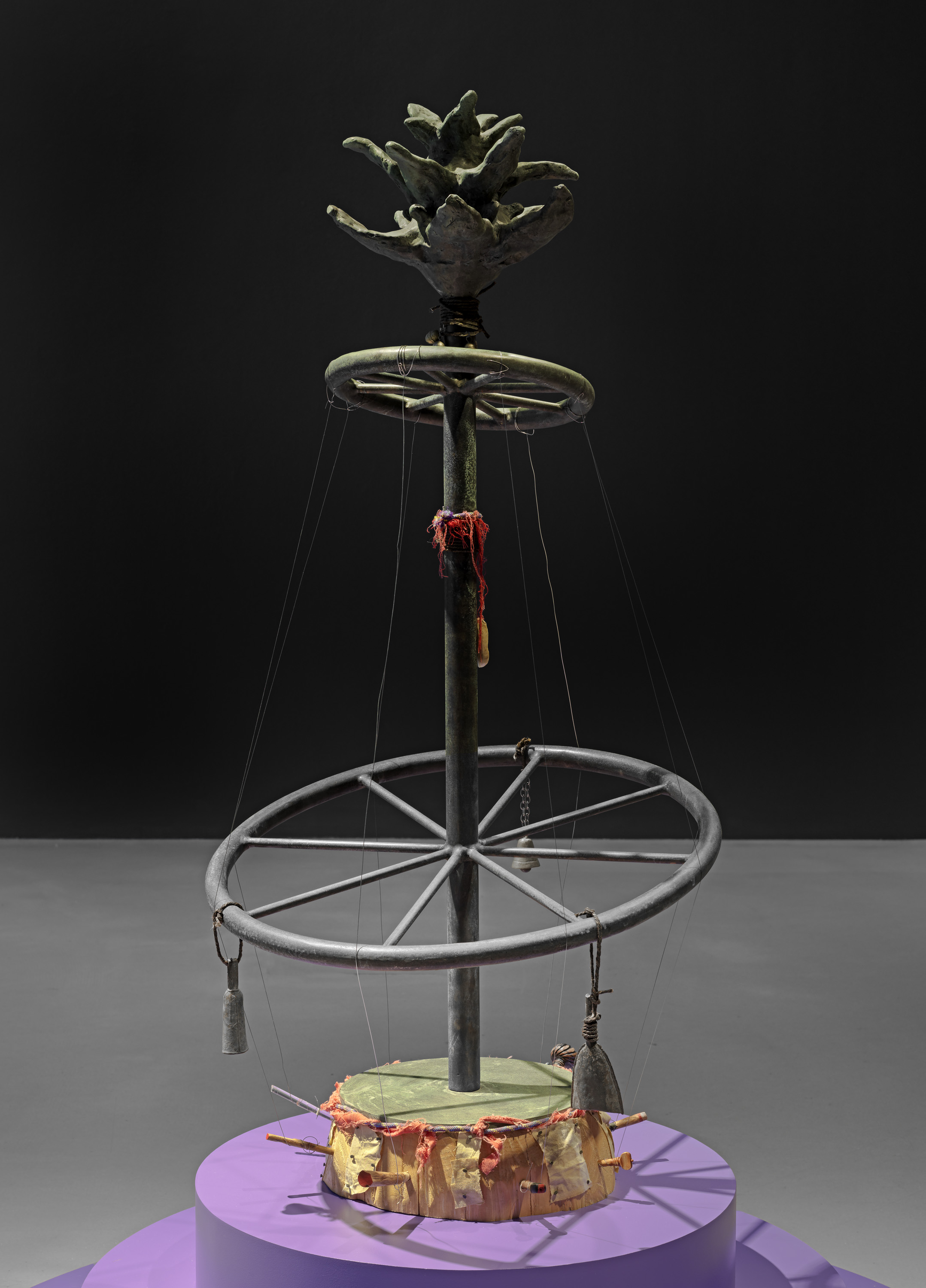


On Exactitude
Solo Exhibition at Indigo+Madder
London, UK
09/10/2023 - 18/11/2023
…In that Empire, the Art of Cartography attained such Perfection that the map of a single Province occupied the entirety of a City, and the map of the Empire, the entirety of a Province. In time, those Unconscionable Maps no longer satisfied, and the Cartographers Guilds struck a Map of the Empire whose size was that of the Empire, and which coincided point for point with it. The following Generations, who were not so fond of the Study of Cartography as their Forebears had been, saw that that vast Map was Useless, and not without some Pitilessness was it, that they delivered it up to the Inclemencies of Sun and Winters. In the Deserts of the West, still today, there are Tattered Ruins of that Map, inhabited by Animals and Beggars; in all the Land there is no other Relic of the Disciplines of Geography
The map described by Borges is an expression of geographic conviction. Terrain is organised and drawn within gridded lines of longitude and latitude. The yantra studies, included in On Exactitude and interspersed among Leo Robinson’s works, use a grid to express spiritual conviction. Each line, mark and block of colour is the manifestation of a ritualised process undertaken in a sacred space. Within these symbolic geometries, which in the Buddhist Divyāvadāna are considered ‘psychological apparatus’ used to guide meditation and attain a spiritual goal, colour corresponds to sound.
For Leo Robinson, who also performs and records as a musician, the conceptual links between the visual and aural are almost inconsequential. ‘The technology of religion and spirituality and how practices can be broken down are what interests me’, he says. A survey of his works shows his sources, associated with the realms of spiritual and religious faith, are a broad church. He plummets into the ancient Chinese text, I Ching, that explores the unconscious and has immersed himself in the Yoruba religion, Ifa. Any system that has he sees as having been developed to offer transformation becomes a part of his pallet. Images of jazz musicians, clippings of text explaining the phenomenon of psychic architecture, a sculptural icon and part of a bone, are just some of the components Robinson orchestrates to form his cosmographic collages.
Anachronistic and intercultural, works like Day-Strife-Sun-Power, including a photograph of two swords matched with a red fabric swatch and a knot of bungee ropes, or Night-Rest-Moon-Seed, featuring an iron tablet along with an image of a flower, feel implicated in an occult ceremony. A table is laid out with works — some deemed mantras, another an oracle— in an arrangement that evokes collective worship. Looking onto the assemblages and reading the handwritten notes provokes questions around the suggested, enigmatic practice. The compulsion to derive meaning from the items, forms and colours brought together is demonstrative of Robinson’s conviction that humans need abstract systems to structure their reality. And while he welcomes the suggestion that each element is symbolic, ultimately, he enjoys cultivating a practice where, as he says, ‘the goal is never actually attained’.
by Dr Cleo Roberts-Komireddi
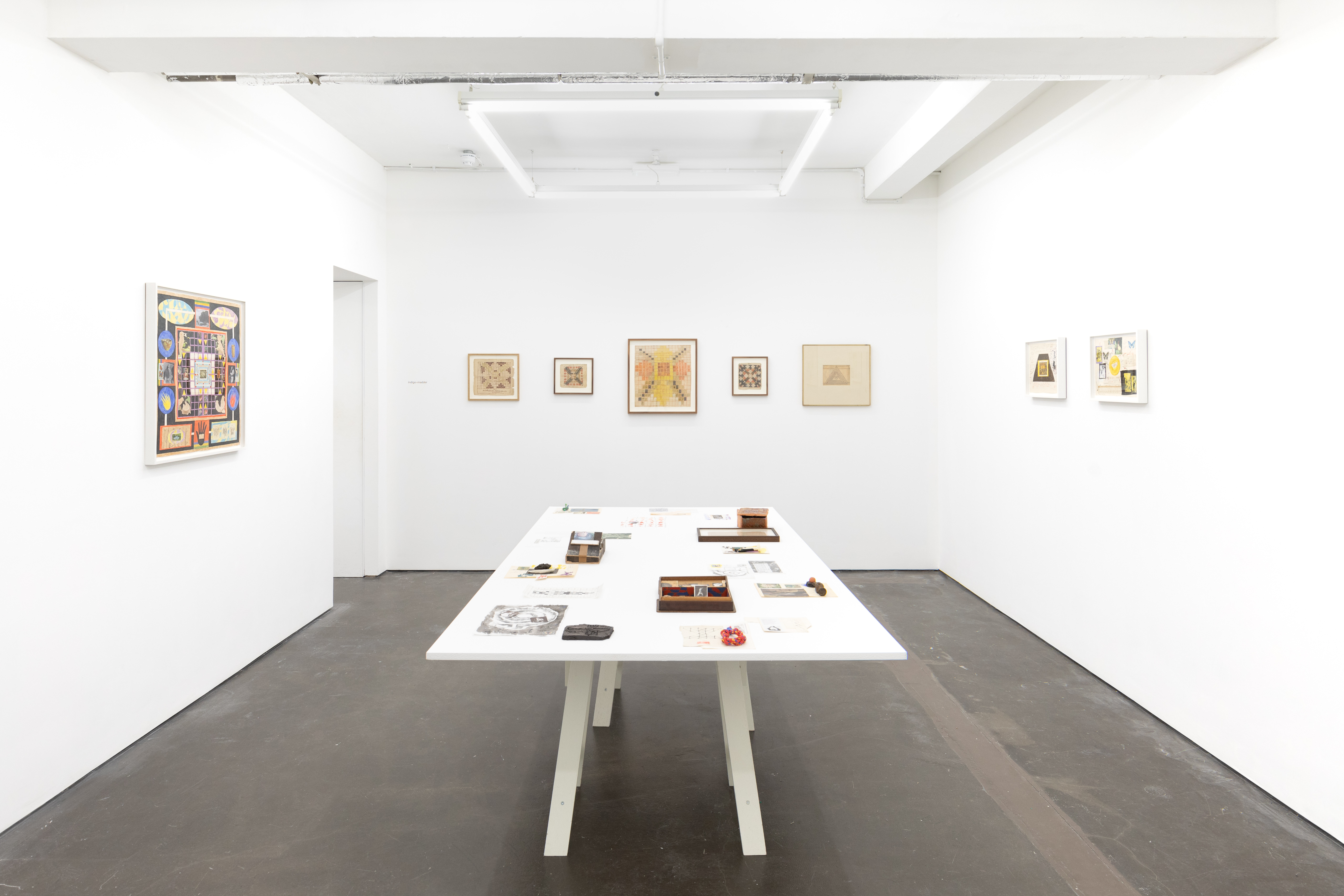
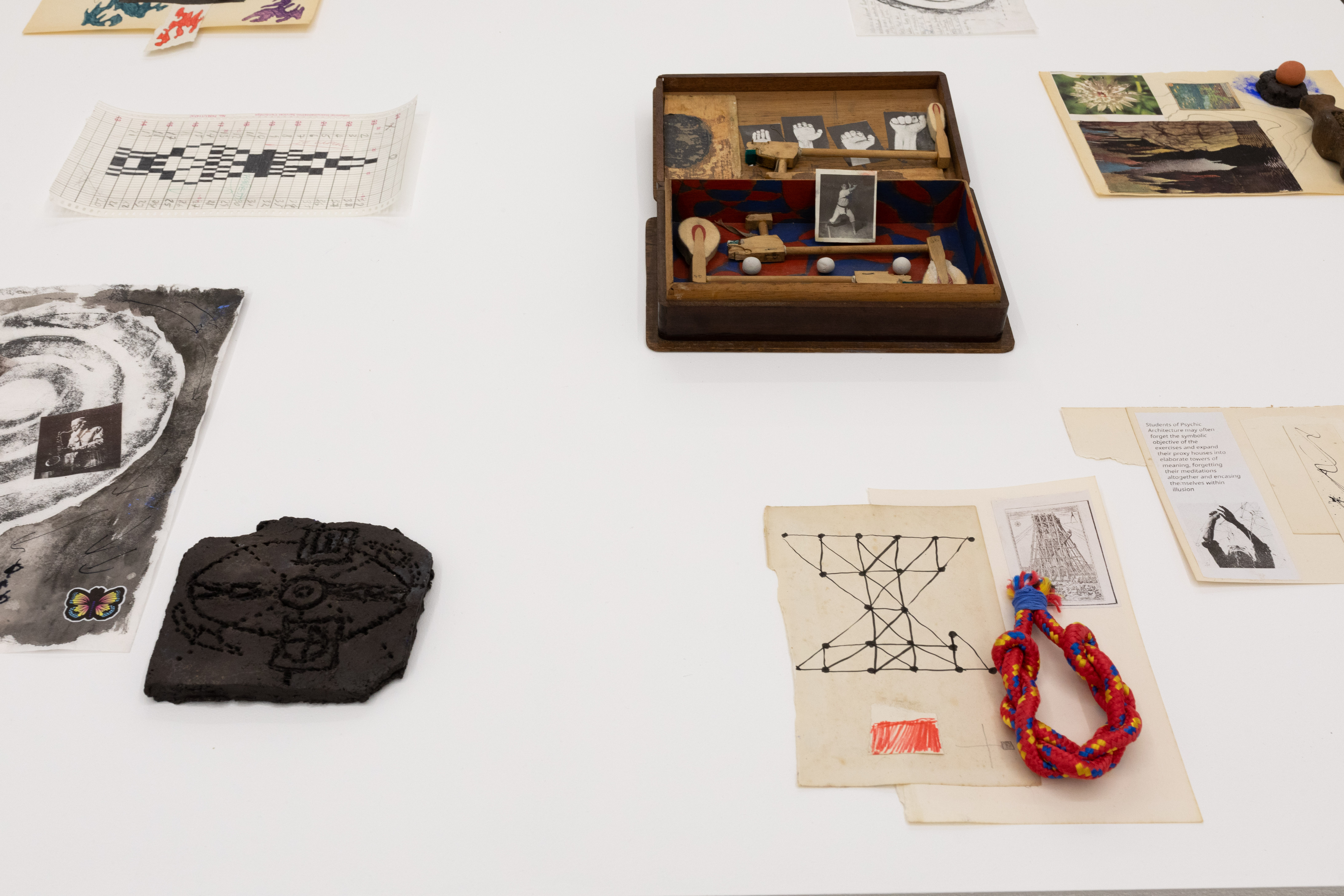
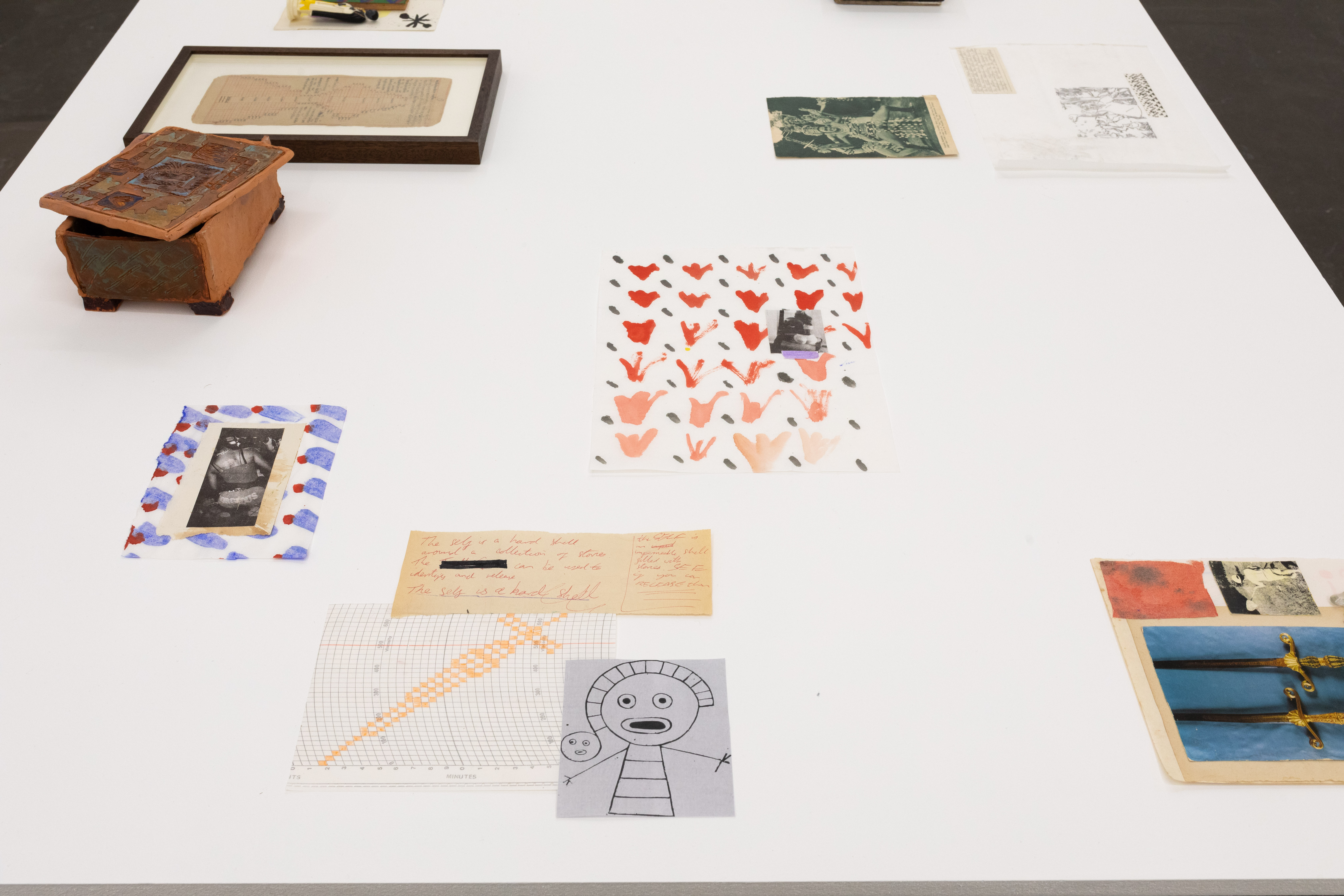
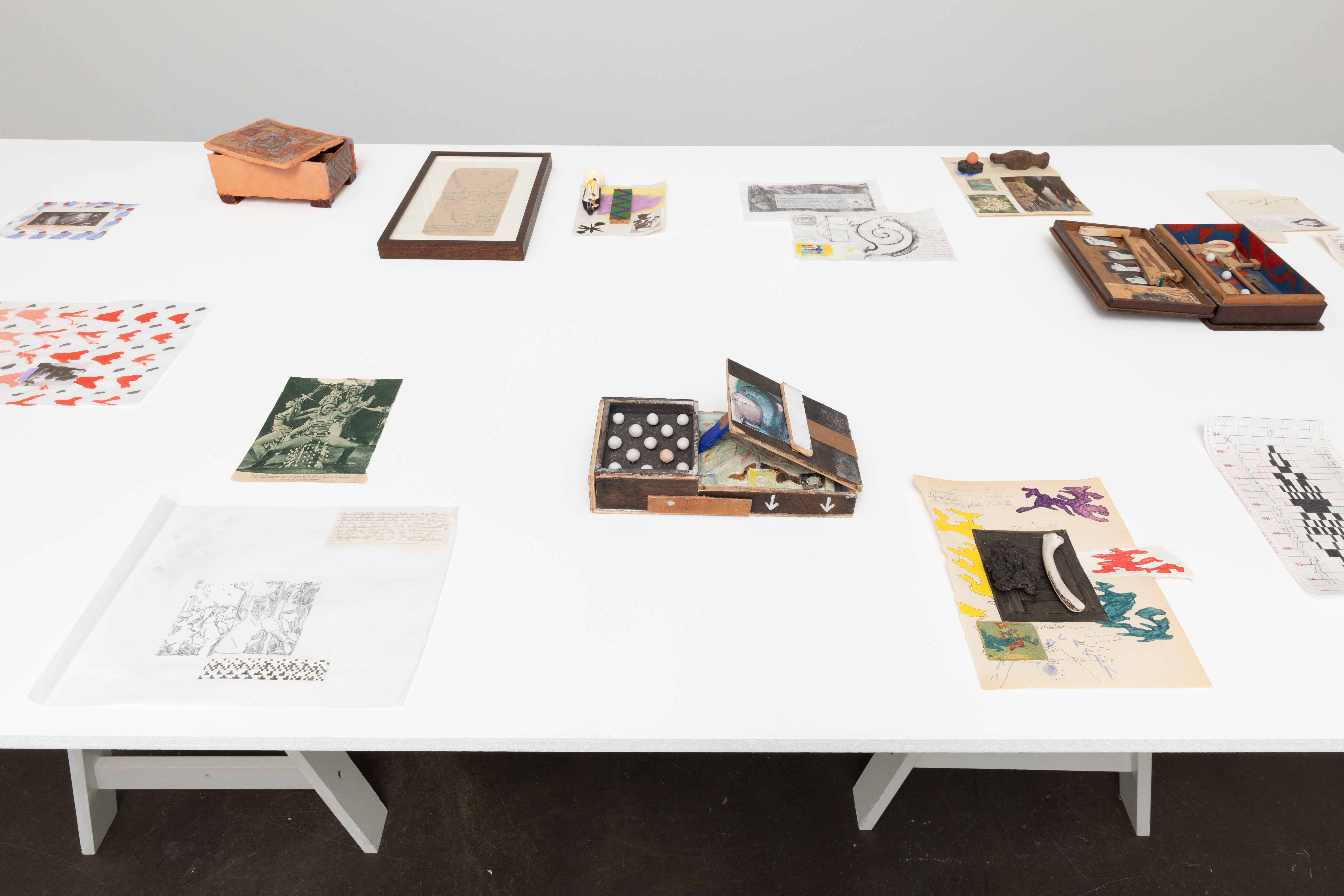
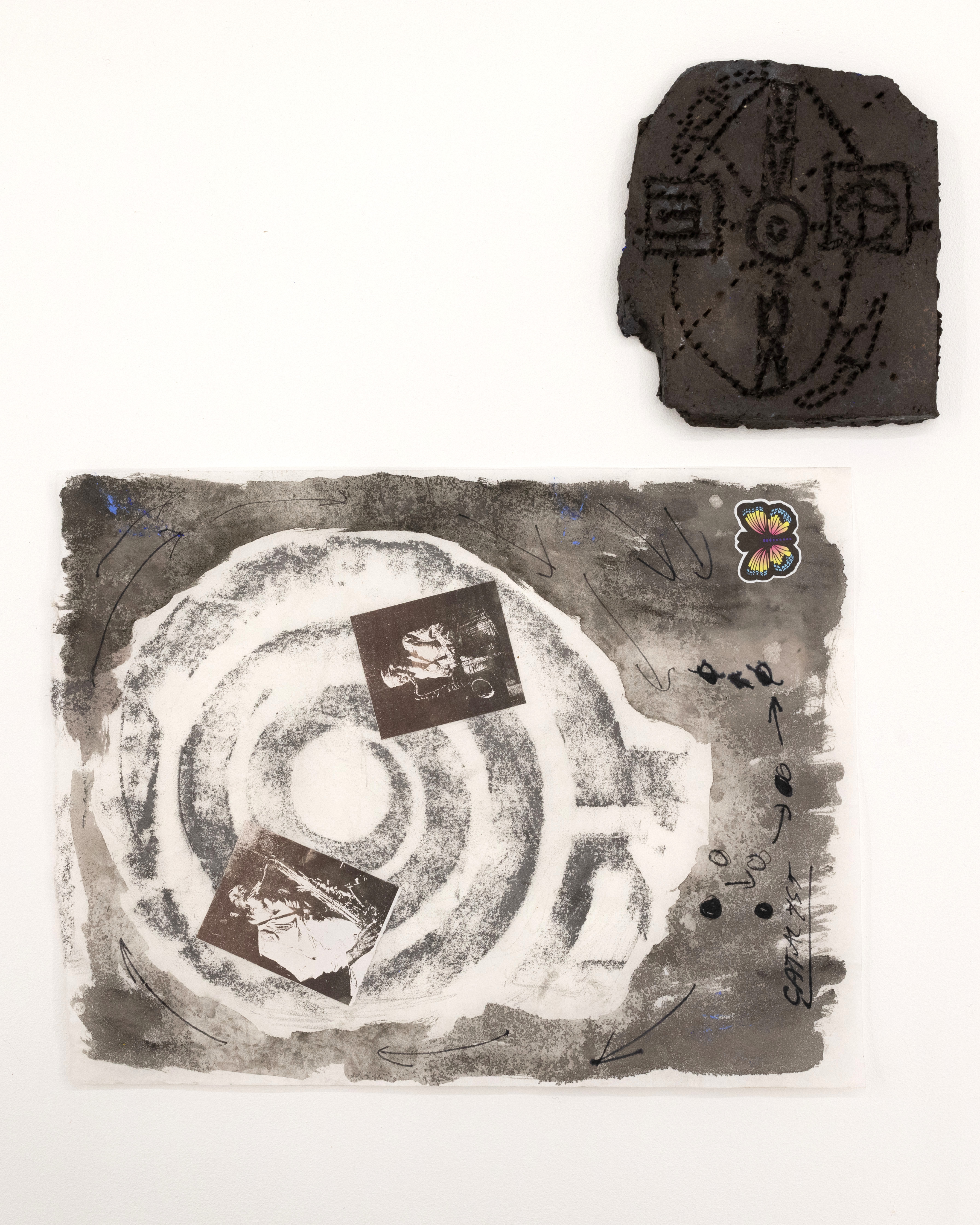

The Infinity Card
Solo Exhibition at Chapter Arts Centre
Cardiff, UK
10/12/2022 - 16/04/2023
For his first major solo exhibition in Wales, Leo Robinson, presents oracles, musical scores and objects that explore a speculative future. In this, new belief systems for the cultivation of self-knowledge have been rebuilt and reimagined, as an act of healing, from the destructive legacies of colonialism. Drawing on his study and use of the divination method of I Ching, Robinson’s rich world-building imagines a post-diasporic future in which ancient cosmologies and indigenous knowledge systems have informed and evolved new rituals and practices that guide spiritual journeys of transformation.
Robinson’s artworks take the forms of paintings, sculptures and collages that include found objects and images alongside instructive texts and musical notations. The ephemera of contemporary culture including Pokémon cards, children’s stickers and printed images from Instagram and TikTok feeds feature across the works, grounding them in a near-distant future.
Central to the exhibition is Robinson’s symbolist language which recurs throughout the works: the net, the flame, the blooming flower, the primate, the vessel, the cross, and variations play out in an endless psychodrama. Within each work lies the potential for transformation from one psychological state to the next, yet the path is not always clear. Robinson’s work asks us to be open to the power and potential of ritual-making to make sense of our inner worlds and the world around us.
Read an Exhibition Text by Joseph Morgan Schofield here.
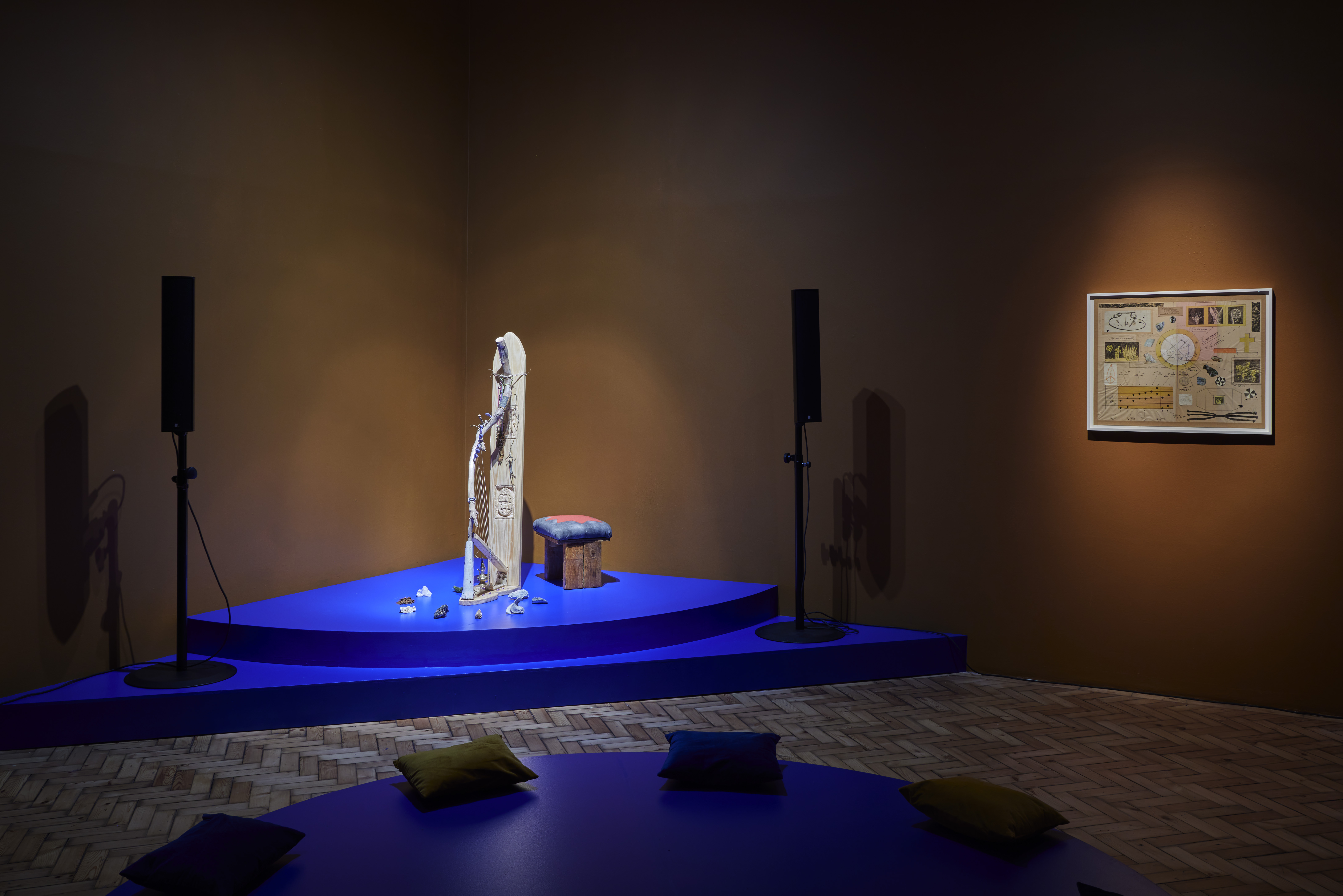
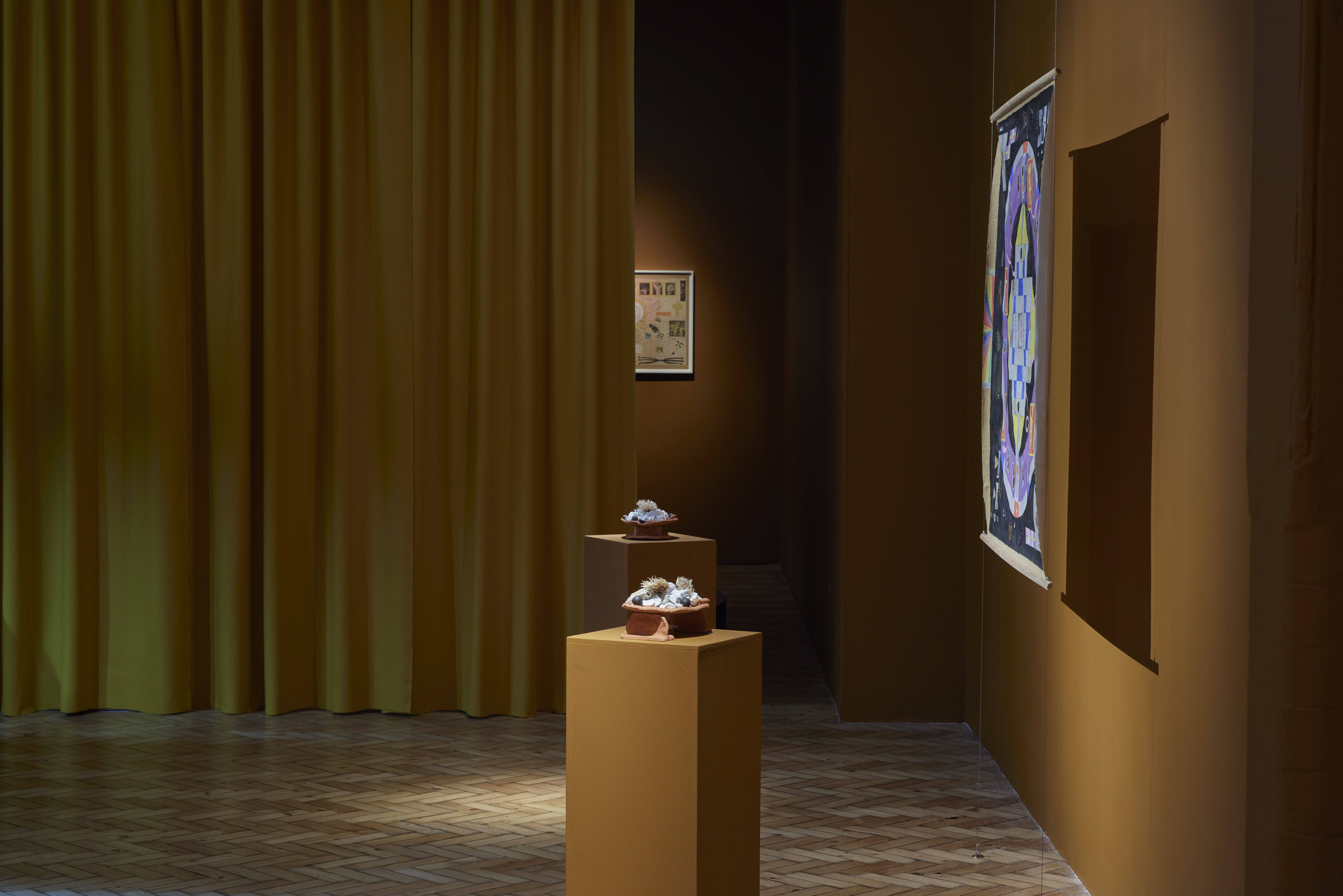
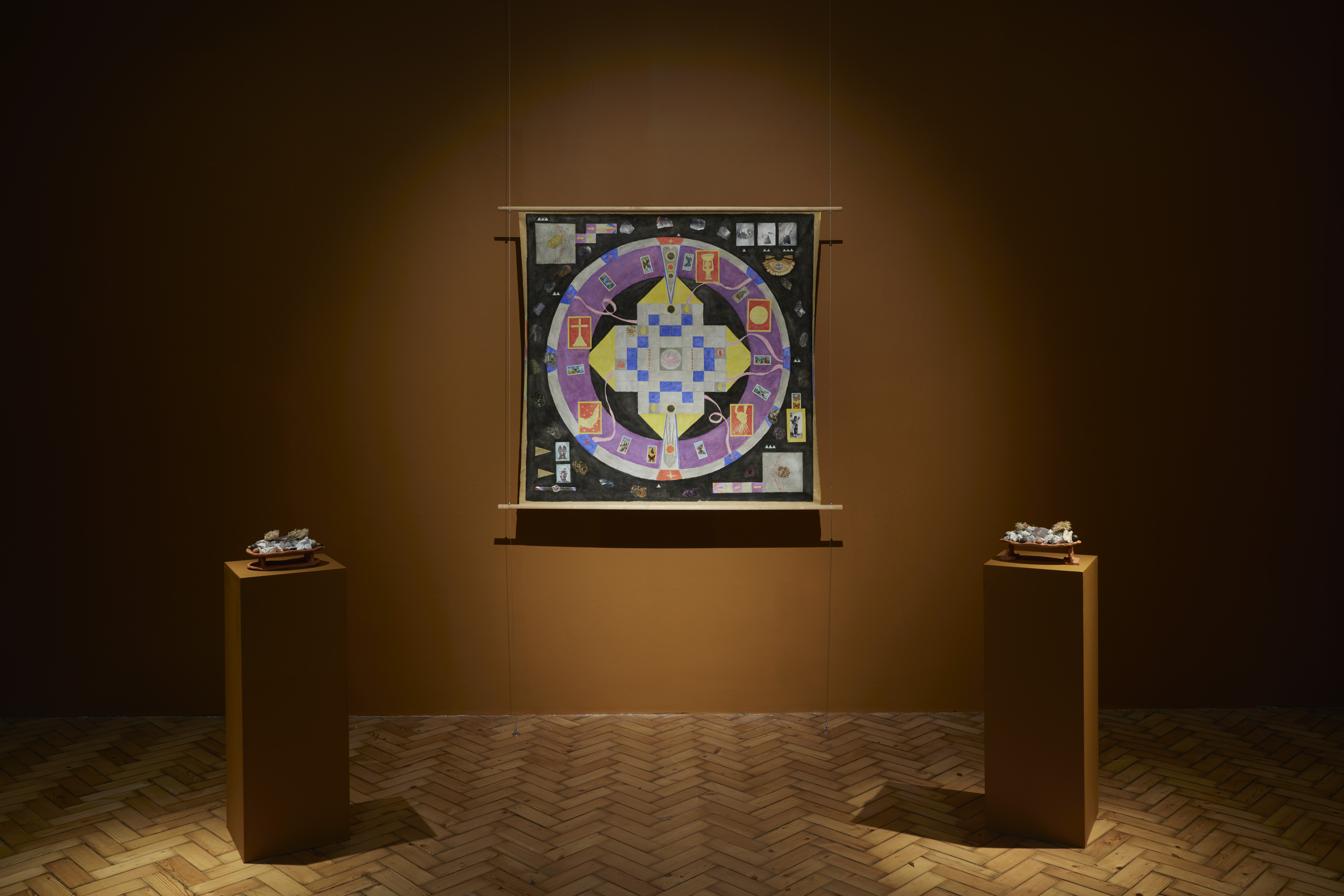


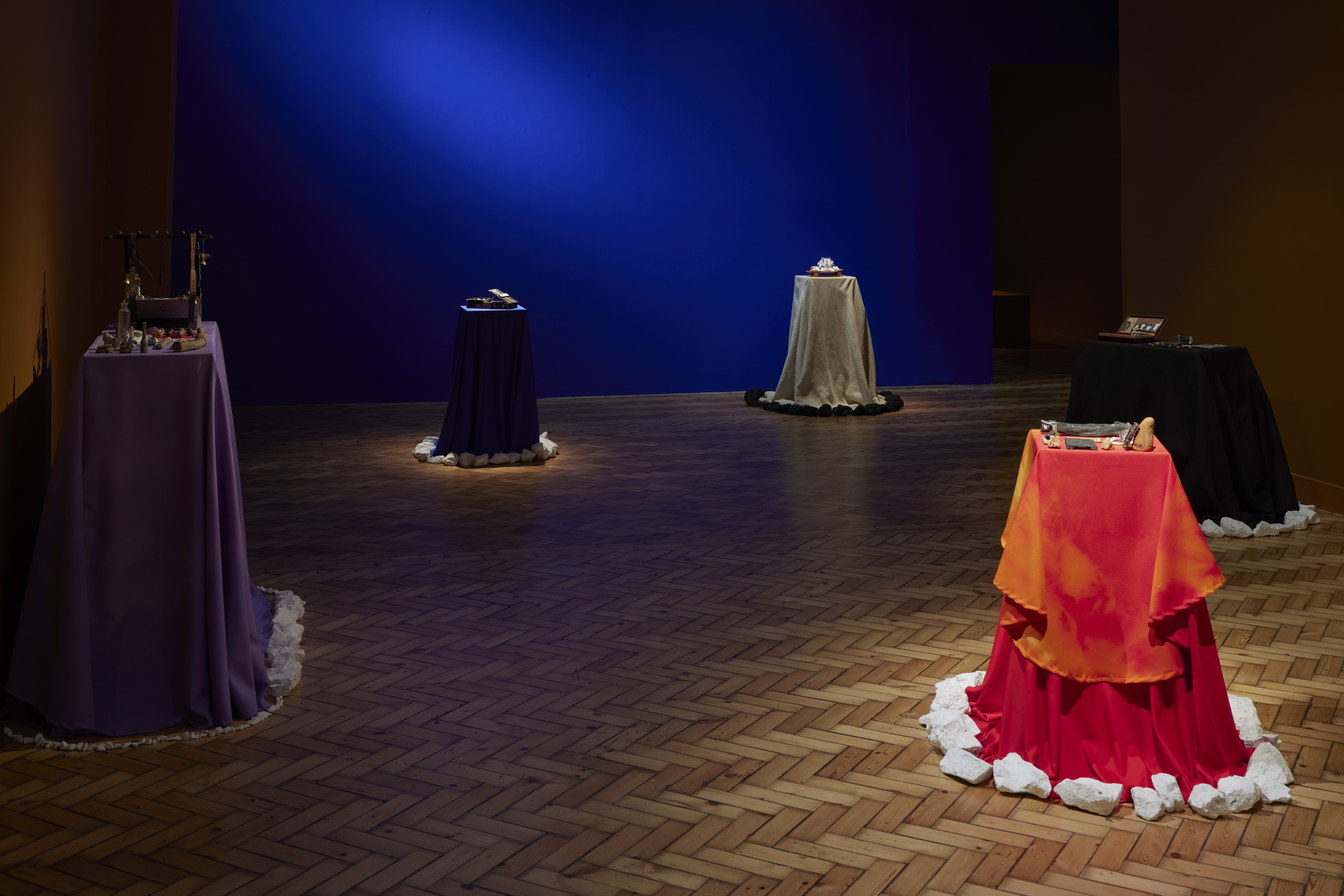
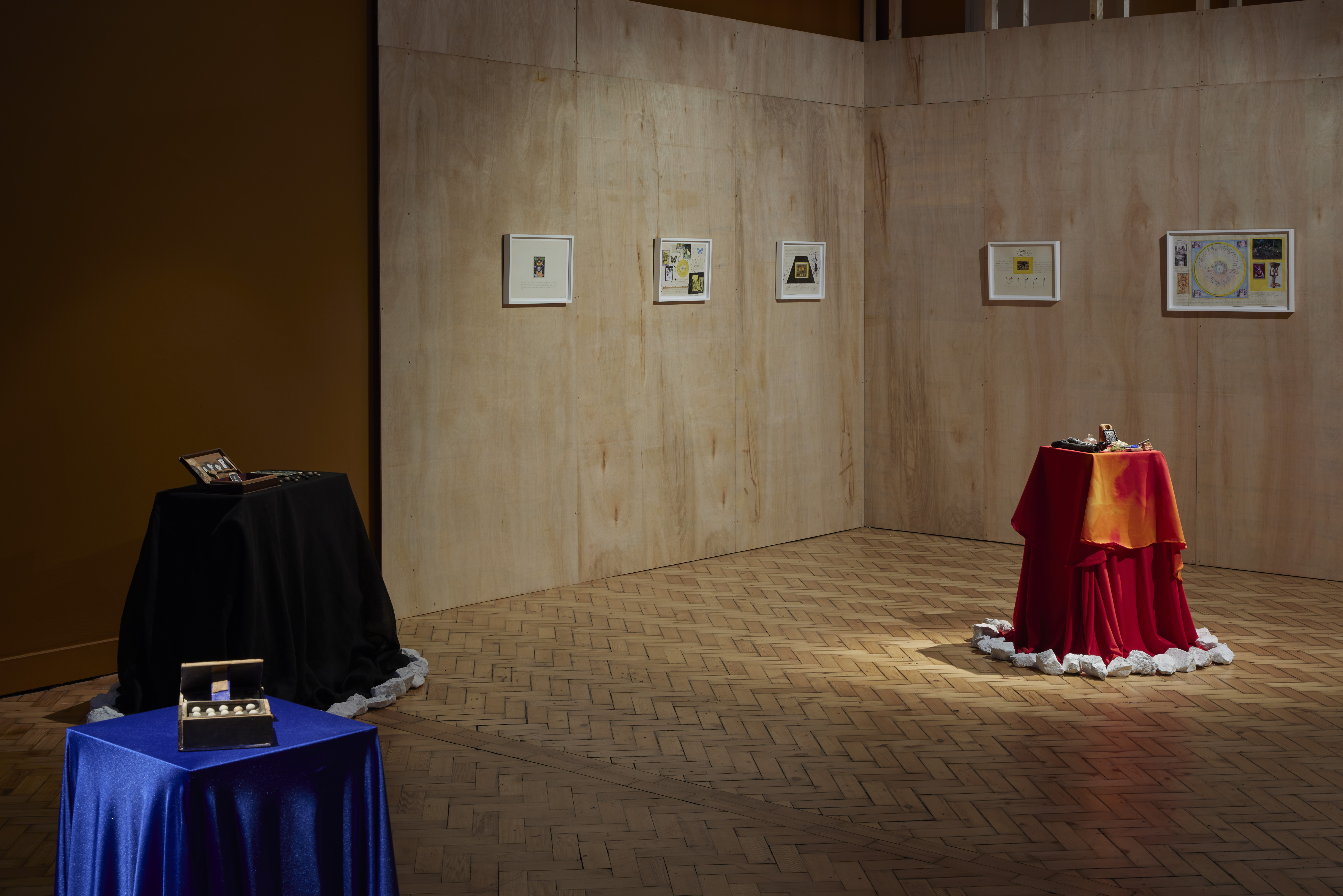
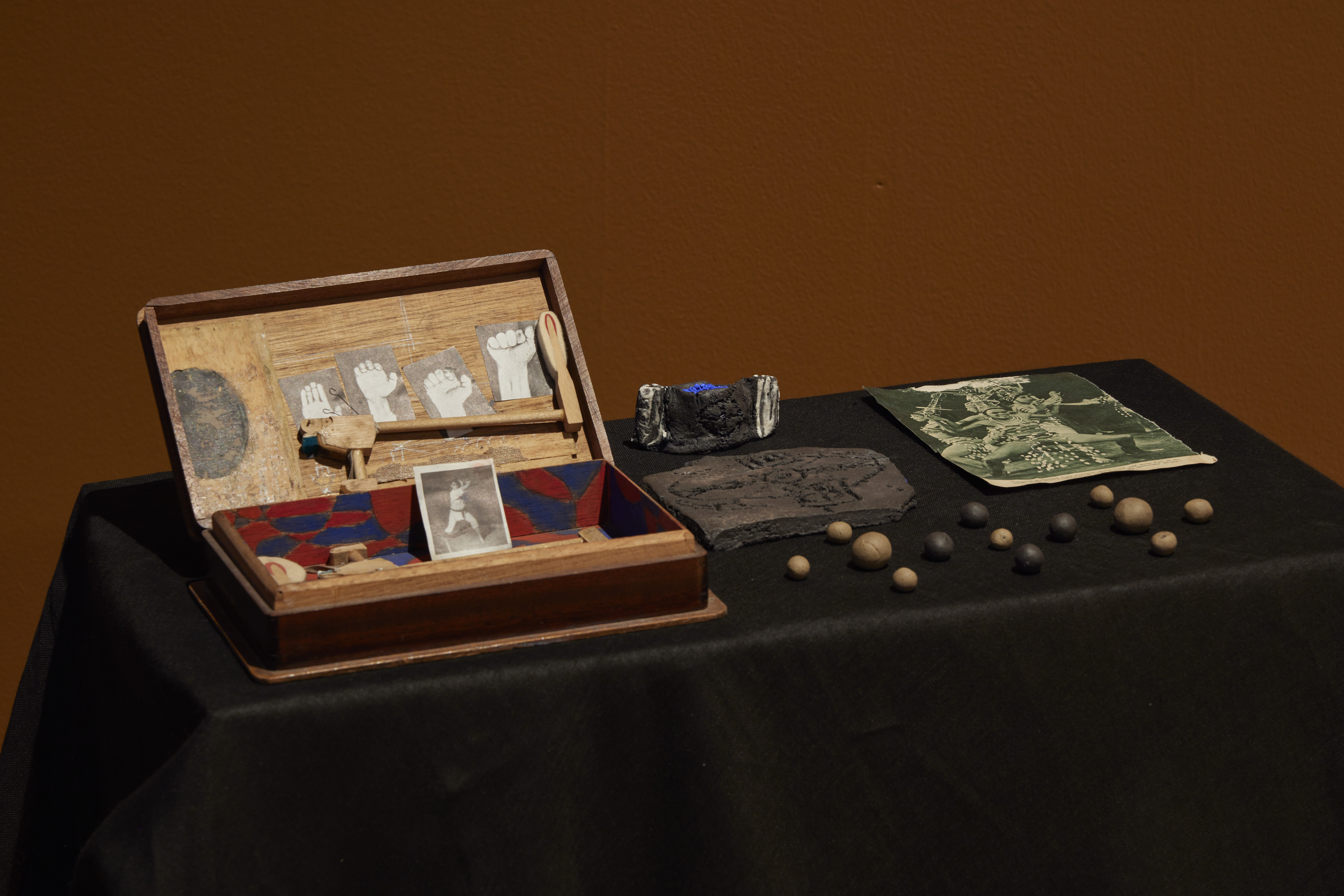

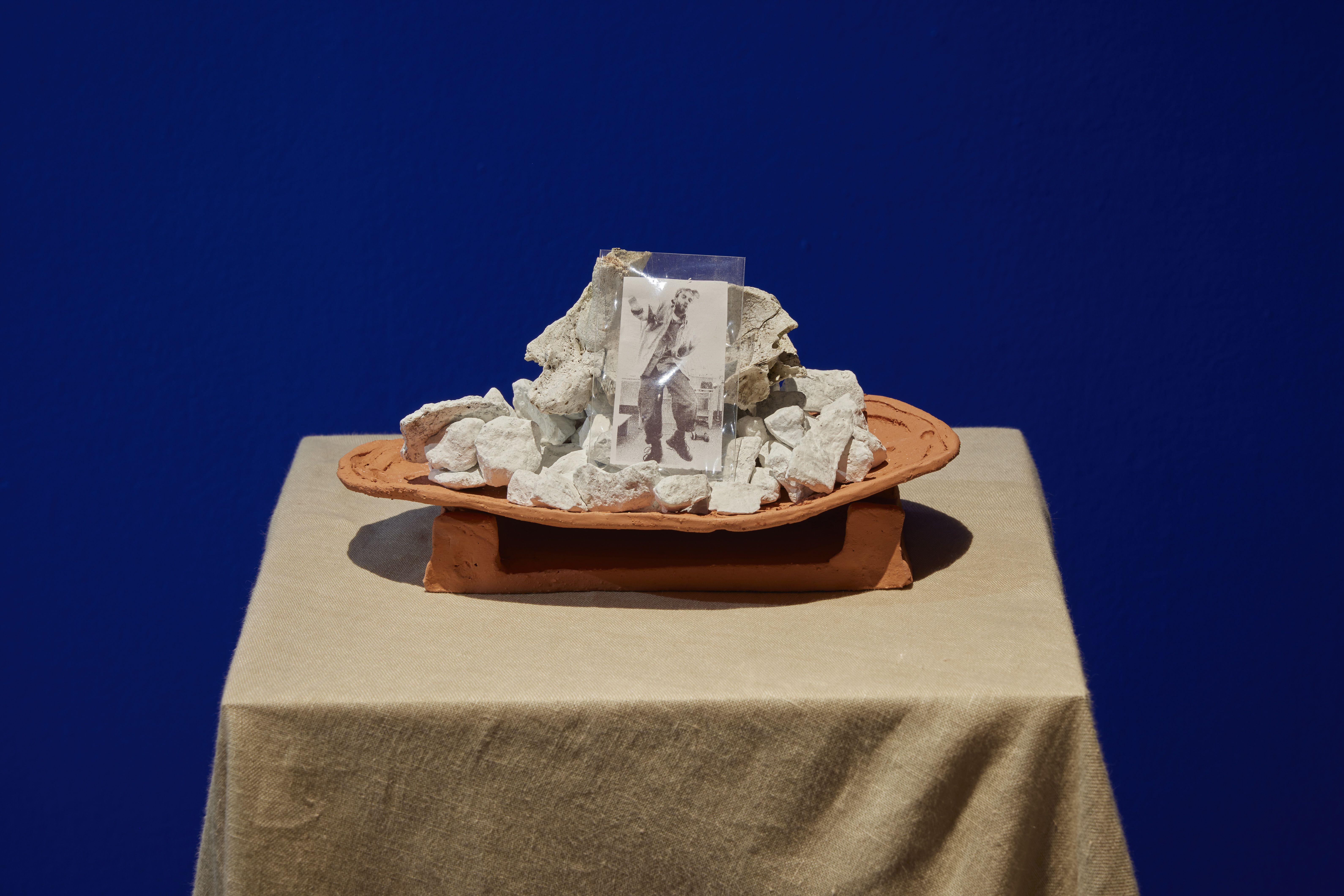

Theories for Cosmic Joy
Solo Exhibition at Tiwani Contemporary
London, UK
05/07/2019 - 13/09/2019
Theories for Cosmic Joy showcases new, previously unseen work developed by Robinson over the past two years. Robinson produces diverse and symbolically rich work, spanning drawing, collage, watercolour, sculpture and video. The exhibition focusses on works on paper which illuminate the philosophical and mystical explorations of his practice.
In his work, Robinson narrates the origin stories and founding myths of a fictional micro-civilisation, whose knowledge, beliefs, art, morals and customs echo real-world cultural constructs. This world-building exercise allows the artist to explore and critique fundamental ideas relating to the blocs of thinking that make up civilisation, such as progress, religion and aesthetics. Referencing Plato, and the birth of conceptual thought, Robinson is interested in studying how humans deal with the prospect of transformation through abstract belief formation, and observes the human tendency to cling to ideas with the expectation of transcendental or transformative outcomes.
The works on paper in the exhibition are inspired by folk-tale illustrations, scientific drawings, illustrated teaching books and the visionary work of William Blake. In Newton with Horse Christ (2019), Robinson pays homage to William Blake’s portrait of the English scientist. Echoing the original watercolour, which questioned the relationship between science and religion, Robinson’s Newton is depicted following the rules of his compass, seemingly oblivious to his surroundings. Meanwhile a black horse, a symbolic deity whose thigh is tattooed with a cross, stands besides him. Technology and science often feature as tangible, propelling forces within Robinson’s fictional world, and recurring elements, such as grids and surreal machines, which are analogous to pixels or nets, attempt to capture and abstract the world from its sensible reality. The artist often counterbalances the propelling forces of progress with their opposites: thus a society which worships technology is also embattled in violent and recurring ideological clashes with obscurantist, anti-science and anarcho-primitivist factions.
Robinson writes: “Both the desire to indulge in abstraction and to cleanse oneself of it are presented on equal terms, as a constant battle between two extremes. The extreme dualities that exist not only in the mind but in external circumstances, such as current socio-political conflicts and religious debate also played a part in the conflict that exists within the work.”
Presenting such oppositions is a way for the artist to explore the Buddhist concept of the ‘middle way’ or moderation, a path which reconciles or transcends the duality between asceticism and indulgence.
